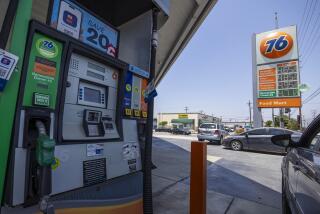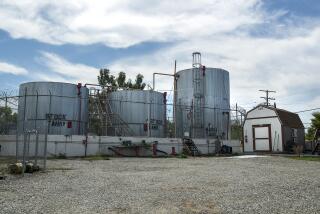Oil changes every 3,000 miles: not for everyone
“Has it been 3,000 miles yet?” asks a banner hanging outside a Southern California quick oil change outlet.
The message -- also conveyed on stickers placed by many quick oil change shops inside customer windshields -- is to hurry back for another oil change.
But the state of California has a different message: Unnecessary oil changes are wasting money for consumers and creating millions of gallons of hazardous waste in the form of used oil.
Instead of listening to the advice of the car service industry, state officials are asking motorists to follow the recommendations of vehicle manufacturers printed in the owners manuals, which often specify oil changes at 7,000 miles or more. The officials say this would save 21.6 million gallons of oil waste a year.
Although environmental issues have played a role in consumer car-buying behavior, the concern seems to dissipate when it comes to car maintenance -- despite a fairly large toxic stream that results from the operation of the vast majority of motor vehicles.
It’s not that consumers are pollution happy. But they are guided by conventional wisdom, handed down from generation to generation, that frequent oil changes can vastly improve the life of their car’s engine and reduce costly repairs.
I can’t say there is no truth to the conventional wisdom, because certain makes and models are afflicted by oil sludge problems that are helped by frequent oil changes. But the longevity of motor oil has improved remarkably over the decades.
A key turning point came in the 1970s with the phasing out of leaded gasoline, which significantly added to the contamination of engine oil. Since then, engine technology has vastly improved to keep oil cleaner through improved tolerances and crankcase ventilation. And, most important, oil has improved with new types of additives that keep the oil working longer.
Vehicle manufacturers have recognized that their engines don’t need oil changes as frequently, but the service industry and consumers have stuck with past practices.
“We are not trying to come across as experts in cars or trying to get in the way of commerce, but if you had a service, wouldn’t you want customers to come back every 3,000 miles instead of every 7,500 miles,” said Bert Wenzel, who helps run the program for the California Integrated Waste Management Board, a part of the state’s Environmental Protection Agency.
A yearlong survey of motorists, concluded in January 2006, found that 73% of California drivers change their oil more frequently than recommended by their vehicle manufacturer. I wonder whether these folks get their teeth cleaned more frequently than recommended by their dentist.
The survey, conducted by Cal State San Marcos, found that about a quarter of drivers used the stickers on their windshield to decide when to get an oil change. Those stickers are widely used by the quick oil change industry, including Jiffy Lube.
Jiffy Lube spokeswoman Virginia Sanchez said the 3,000-mile oil change is justified when vehicles are driven under severe conditions, such as short trips, stop-and-go driving or extreme temperatures.
“A 3,000 severe-service interval holds true for the majority of the cars on the road in the U.S. today,” Sanchez said.
That is, in my view, a self-serving overstatement of what severe duty means. All driving, by definition, involves stopping and going. But encountering an occasional traffic jam is different from operating a taxi in Manhattan.
Richard Sullivan also takes issue with that statement. Sullivan, a former General Motors service manager and deputy for field operations and enforcement at the California Bureau of Automotive Repair, a state agency that regulates the car service industry, said the only person who can be a fair judge of whether a vehicle is subject to severe service is an informed consumer.
As an example of severe service, he cited a vehicle used in Lake Tahoe. For an engine, it is far different to make a short trip up a steep mountain grade in freezing weather than a short trip on a flat road in 50-degree Los Angeles winter weather.
EZ Lube, another Southern California chain, uses store banners asking whether it has been 3,000 miles since your last oil change. This company paid a $5-million settlement in December after it was charged with systematically charging Southern California customers for unnecessary repairs on their vehicles -- often brought in for oil changes.
California uses about 152 million gallons of automotive lubricants -- crankcase oil, gearbox oil and transmission fluid -- each year.
About 50 million gallons of that oil is either burned in engines or dripped onto the highway, the board estimates. An additional 14 million gallons disappears, presumably dumped into the ground or storm drains by backyard mechanics, Wenzel said.
That leaves about 88 million of the original 152 million gallons of hazardous waste to be disposed. Every gallon of toxic waste is a big deal and fewer oil changes could help, Wenzel said.
ralph.vartabedian@latimes.com
More to Read
Sign up for Essential California
The most important California stories and recommendations in your inbox every morning.
You may occasionally receive promotional content from the Los Angeles Times.











